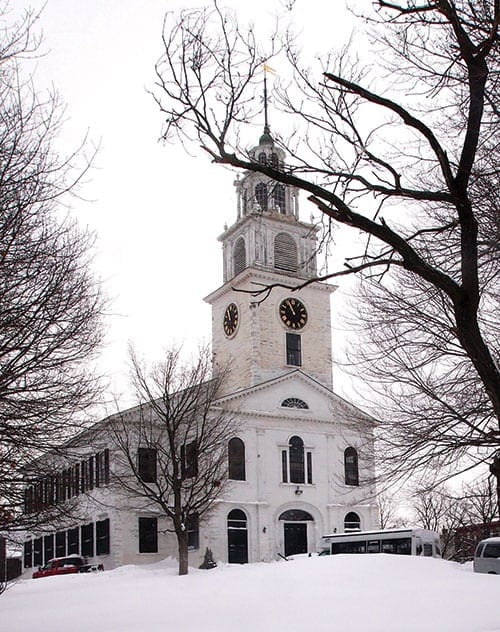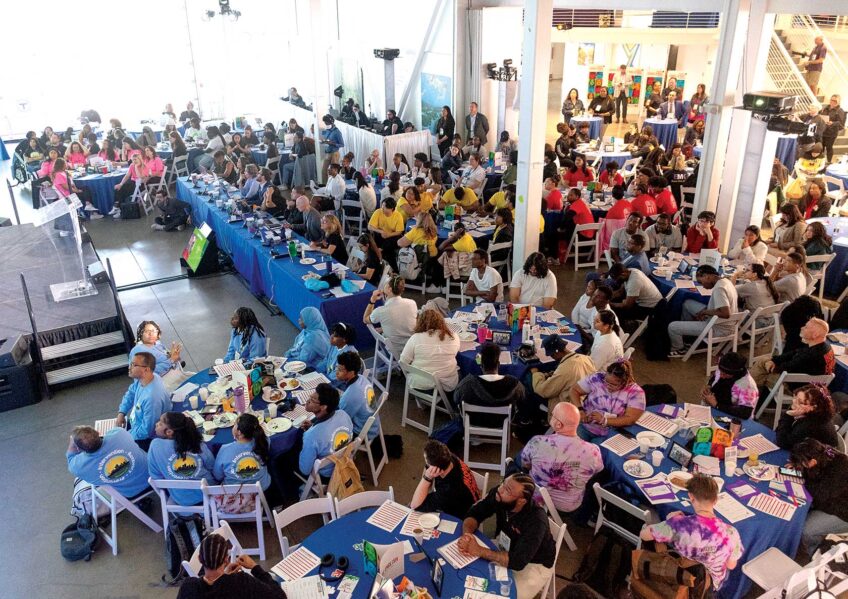
Editor’s note: Blacks began moving into Roxbury in sizeable numbers in the 1930s. But for the prior 300 years, the Puritan settlement and later Town of Roxbury had few black inhabitants. Blacks have, nevertheless, embraced the history of the neighborhood in its fullness. The following is a look back at Roxbury’s historic landmarks from an 1895 book written just 37 years after the town was annexed by Boston.
Historic pride and preservation efforts in Roxbury are hardly a new trend. More than 100 years ago, an impressive volume, “Picturesque Boston Highlands (Roxbury), Jamaica Plain and Dorchester,” offered an 1895 account of many areas that had then already endured as Roxbury landmarks.

The seal of the town of Roxbury, which was originally founded as a Puritan settlement in 1630.

A parting stone marker, noting the distance to the old State House. Roxbury resident Paul Dudley installed the markers on colonial-era roadways throughout the Greater Boston area.
Eustis Street Burial Ground
The final resting place for Rev. John Eliot, the Warrens, the Dudleys and many other of Roxbury’s founders and leading citizens is one of the oldest cemeteries in New England. It also includes 400 to 500 veterans of the French and Indian War.
The Eliot Burial Ground, also known as the Eustis Street Burial Ground, had its first burial in 1633. The 1895 account mentions the oldest gravestone then standing dated to 1653. True history buffs may wish to see if it has lasted another hundred years.
The 1895 history, written just a few years following Roxbury’s annexation to Boston, reflected what was already lingering resentment to annexation in its derision of the poor upkeep of the burying ground. “The present condition of this hallowed spot is a disgrace to the wealthy and cultured’ city within whose jurisdiction it now lies,” the text read, “and an indirect disgrace to the entire commonwealth of Massachusetts…”
“As the matter stands,” the tract continued, “the people of Roxbury are blamed for a grievous fault for which the city government of Boston is responsible. When Roxbury was an independent city it took good care of this historic ground.”
Having made its denunciation, the book went on to explain that Roxbury residents had taken the affair “into their own hands…to arrange it so that desecration will proceed no further…”
In 1974, the cemetery was declared a National Historic Site and nine years ago another revitalization was underway, sponsored by the Boston Parks and Recreation Department and the Boston Landmarks Commission, and, as in the last century, with significant input from local residents.
“What’s unique about it is that it’s there,” historian and state Rep. Byron Rushing said at the time in a Banner report. “It was the first cemetery in Roxbury. There were others and they [were] moved.
“It’s probably in the best condition of any of them,” he continued. “Anyone who wants to see a historic cemetery in Boston should go there.”
Washington Street
“This is the longest street in the world,” the “Picturesque” book boasted unabashedly. “It being 44 miles in length. For many years, it was the only thoroughfare connecting Boston with the mainland, for ancient Boston was almost an island, it being entirely surrounded by water and by impassable salt marshes, flooded at high tide.”
Whatever the merit of the longest-in-the-world claim (two Western Avenues, one in Chicago and one in Los Angeles, run some 40 miles all within the city limits; the local entry goes through many different communities and another state before its terminus in Providence, Rhode Island) Washington Street is certainly one of this area’s oldest — already in 1631 a thoroughfare on the neck connecting Boston to the mainland. It received its present name after a visit by President Washington in 1789.
Roxbury High Fort
The 1895 entry related that “the first regular fort built by the patriots when they began the siege of Boston” was located on the Bradlee estate, on the corner of Highland and Cedar streets, then and still so named. On Fort Street, it continued, the side of the fort is marked by the Roxbury Standpipe, which today is often confused as being part of the fort itself. Observant visitors then and now will notice an inscription on the standpipe: “On this eminence stood Roxbury High Fort, a strong earthwork, planned by Henry Knox and Josiah Waters, and erected by American Army, June 1775, crowning the famous Roxbury lines of investment at the Siege of Boston.”
In a diversion from its account of physical landmarks, the 1895 text also included a commentary on social changes in the area, namely, that of public drunkenness. “Strong liquors were much more commonly used in Colonial days than they are now,” the book explained, “but our ancestors discriminated strongly between use and abuse.”
To illustrate just now seriously the colonial forebears took public drunkenness, the book quoted the sentence given one Robert Coles on March 4, 1633:
“For drunkenness by him committed at Rocksbury he shal be disfranchised, were about his necke & soe to hang upon his outward garment a D made of redd clothe & sette upon white, to contynue this for a yeare and not to leave it off at any time when he comes amongst company under penalty of XL shillings for the first offence and V pounds for the second, & after to the punished by the courte as they thinke meete; also he is to weare the D outwardes and is enjoyed to appear at the next Generalle court & to contynue there until the court be ended.”






